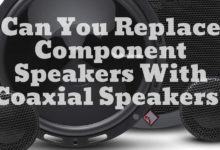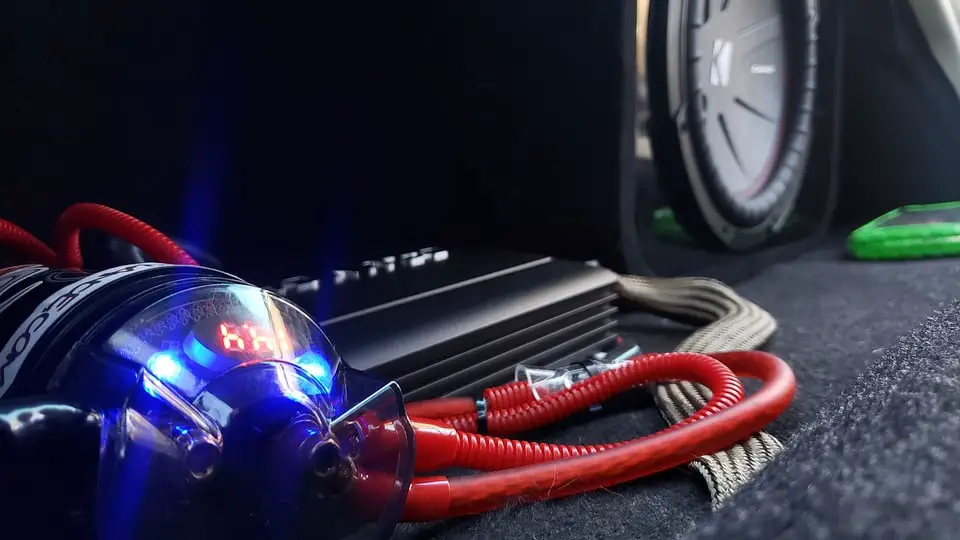This article will discuss the difference between coaxial VS component speakers. We will also be discussing how they function, their advantages, disadvantages, and more. All of this is to help you decide which kind of speaker would best suit your needs.
The odds are you intend to get brand new speakers for your car, that’s why you are here. New car speakers can have a great effect on the sound performance of your vehicle.
People are different, they want different things, and they have different budgets. The budget is one of the most important factors that come into play when you want to get new speakers for obvious reasons.
In all of the above, it is imperative that you grasp the difference between component and coaxial speakers before you make that purchase.
In this article, we are going to learn the difference between the two, the sound they deliver, and many more that will help you determine the best choice for you.
Table of Contents
Difference Between Coaxial VS Component Speakers
Coaxial Speakers
These are essentially two-way speaker systems that are assembled into a single piece, what this means is that the woofer, a simple crossover, and the tweeter are all combined to become one.
It is pretty convenient when you think about it. The coaxial speakers are built-in in that manner to oust speakers with lower qualities as they are compatible with the same hole for installation. As opposed to speakers with single cones, coaxial speakers offer better sound.
In a certain way, coaxial speakers are a compromise between more advanced component speakers and single cone speakers which have substandard sound quality.
Coaxial speakers are often preferred by a plethora of individuals because they perform impeccably, are convenient, and do not break the bank. What’s not to love about them?
Merits Of Coaxial Speakers
- Easy Upgrade: The easy choice to upgrade your sound system.
- Affordable: Coaxial speakers come with a vast range of price options and sound performance for individuals. It comes with higher power ratings, better crossover design, better tweeter quality, cone materials, and many other impressive features.
- Convenience: Here comes the convenience we spoke of earlier, the fact that coaxial speakers are two way speakers built together saves you the stress of saving two separate two way component car speakers.
- Accessibility: Because of the high demand from clients to get these speakers, manufacturers keep producing them in numbers each year. You don’t have to comb the market to get them, odds are they are the first things the attendant will give to you when you request for car speakers.
Single Cone Speakers VS Coaxial Speakers
You get better sound from coaxial speakers as opposed to single cone speakers which are substandard. The two-way feature of the coaxial speaker makes it produce split sound and gives you the best sound performance so it always wins. The two-way feature ensures that you have full-range sound.
Most speakers that come installed with new vehicles sound awful, yes, these manufacturers do not seem to pay much attention to detail when they produce them.
Although if you are not an audiophile, you can make do with the ones they provide for you. But I guess you are an audiophile, that’s why you are here in the first place.
The reason these car speakers sound terrible is that they have just one midrange/woofer which will certainly not get the job done.
Without any exception, all single cone speakers are not equipped to give you great sound like the aforementioned coaxial speakers.
A tweeter is equipped with a coaxial speaker to cater to the musical range’s upped end, this allows the coaxial to deliver sounds that other speakers are unable to produce.
Three-Way Or Two Way Coaxial Speakers: Which Is Better?
Before I answer the question at the subheader outrightly, let us see the difference between the two. Three-way coaxial speakers are basically extended versions of two-way speakers.
There is a small speaker added that makes it a three-way, this extra speaker is added to boost the sound performance.
However, the fact that a three-way coaxial speaker comes with an extra speaker does not mean it is better than the two way. There are two-way coaxial speaker models that outperform their three-way counterparts.
What you should take away from this comparison is that a well-crafted two-way speaker will do better than the three-way so this does not make any of them better than the other.
What I can tell you is that they are both better than the aforementioned single cone speakers. Now that you have an idea of what a coaxial speaker is all about, let us proceed to talk about component speakers.
Component Speakers
These are speakers that are mounted separately, they are manufactured with more advanced crossovers to give users impeccable sound quality and performance.
If you have coaxial speakers, then getting component speakers will be “up the volume” for you, yes the pun was intended. Yes, yes, component speakers offer better sound than coaxial but wait do not decide just yet, let us go further.
Component speakers have better sound performance because they use more advanced woofer and dome tweeter equipment accompanied by a superior speaker crossover.
What’s more, is that some component speakers are built to be arranged together which makes them seem like coaxial speakers in terms of convenient installation.
Merits Of Component Speakers
- Impeccable Sound Performance: Overall, the component speaker offers better sound accuracy and frequency response as opposed to the coaxial.
- Tweeters: The tweeters of the speakers stronger and perform better than coaxial in all ramifications.
- Power Handling: The power handling on a coaxial speaker is better, it doesn’t matter the reach of the sound music being played or the sound that emanates from the speakers, the component will handle the power.
- The installation accessories and speaker connector are better
- They have superior crossover component quality
However, with all these pros the component speaker has, the installation process is not exactly as convenient as that of the coaxial speaker.
Custom fabrication is needed for the tweeter mounts. Another thing that must be mentioned is the price, component speakers are not as affordable are coaxial speakers, but I am sure you expected this after all the perks you have just read about it. Better quality equals more money.
The Cross Over Differences Between Component And Coaxial Speakers
Now it is time to directly compare these two, although at this point we already have an idea which is better and we already know what it takes to get them.
Earlier in this article, I stated that the crossovers of component speakers are more advanced than the ones used in coaxial speakers.
The crossovers of component speakers utilize two filtering stages as opposed to coaxials that utilize crossovers that use a single stage.
What that entails is that component crossovers ensure more functional bass and midrange sound filtering from both the woofer and tweeter.
A plethora of coaxials utilizes a single cheap capacitor that is linked to the mounted tweeter. Coaxials utilize a lower-cost design that depends totally on the knowledge that several woofers naturally roll off higher frequencies.
This may be true and gets the job done but it jeopardizes what was supposed to be an impeccable sound performance (compared to component speakers of course).
The Design Of The Component Speaker Crossover Is Better
The crossovers of component speakers are custom designed for the speakers, with that sort of attention to detail, you are sure of unique and quality sound performance.
That is not all, oh yes there is more, they are designed with inductors and capacitors of better quality. These inductors and conductors greatly help in keeping undesirable sound away from the speakers.
The final “destination” of this design is lower distortion and better clarity that lets you enjoy the music better than you would on “the other” speaker.
Some manufacturers still go an extra mile with the component speakers, they add a control option for the tweeter volume, isn’t that amazing? That way you are not just in control of the speaker volume, you also control the volume of the things that make it up, that is just fascinating.
You may not see the usefulness of this but it will come in handy when the tweeter seems to sound too harsh to you (this happens).
Some of them have circuit protection for the tweeter to keep them from overheating when high power passes through. All that magic happens to ensure you have impeccable sound performance.
Coaxial And Component Speakers: Wiring
Wiring both of these speakers is not really difficult, that is of course when you do not include the physical stress you have to go through when mounting component speakers.
Wiring Coaxial Speakers: These speakers are wired with the positive and negative wires of the amplifier to the speaker terminals of the same name. This is the same method utilized in the wiring of factory installed speakers.
Wiring Component Speakers: This one is a little bit complex as opposed to coaxial speakers, it is connected to the speaker crossover’s input via the head unit.
Get the crossover’s tweeter output connected to its negative and positive terminals. Get the woofer’s output connected to the positive and negative terminals of the woofer.
Conclusion
Component and coaxial speakers are both impeccable speakers and perform greatly. However, the component speaker outperforms the coaxial but it costs more. You can go for the coaxial if you do not have the funds for a component.




